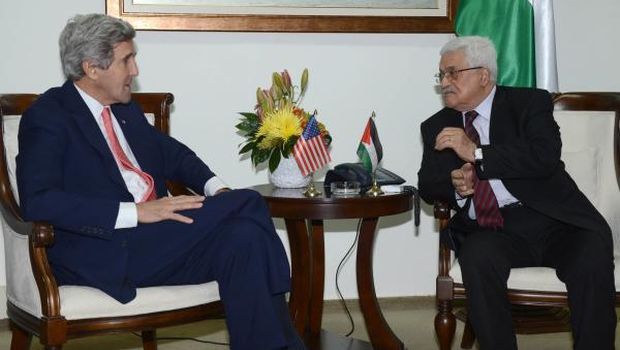Regardless of how stormy and turbulent the events in the Arab region have been over the past three years, the Palestinian territories—whether the Palestinian Authority-controlled West Bank or the Hamas-controlled Gaza Strip—have remained relatively calm and unaffected by the wave of uprisings that have hit most of the countries with historical links to the Palestinian cause, whether in times of peace or war. With the exception of an attempted popular uprising that was immediately put down by Hamas and the Islamist group’s relations with its Muslim Brotherhood parent organization, nothing on the agenda remains except the issue of inter-Palestinian division and reconciliation talks that never came to pass, not to mention attempts to push forward with the prolonged and floundering Israeli–Palestinian peace process.
The Palestinian Authority in Ramallah had no choice but to monitor and follow the developments in the Arab countries that had been key players in the peace process with Israel—particularly Egypt, which has played a vital role in the peace process since the late 1970s. Hamas, however, maintained a higher profile, scrambling to come to terms with the damage to the organization after the Syrian government kicked its leadership out of Damascus. When the Muslim Brotherhood came to power in Egypt, Hamas’ hopes of compensating for this loss grew, only for the group to find itself facing even greater isolation after Islamist President Mohamed Mursi was ousted in a popular uprising. Fearful it would have to pay the price for its former stances, and finding itself in a weaker position given its shrinking influence, Hamas has recently shown greater flexibility towards the prospect of reconciliation with the Palestinian Authority.
This new state of affairs may explain why US Secretary of State John Kerry is prioritizing the Palestinian–Israeli issue, the timing of which prompted suspicion among some observers. In the meantime, the Arab region is in turmoil and witnessing escalating developments. The political scene in the countries that have witnessed transformations is characterized by chaos and unpredictability, while what seems to be a civil war is raging in Syria with reverberations echoing throughout the region and the rest of the world.
The reality is that this is a masterstroke by Kerry; he has seized an opportunity to achieve a breakthrough on an issue that has puzzled several US administrations which exerted significant amounts of energy on it without ever achieving anything—the Clinton administration in particular. Former US President Bill Clinton met with Yasser Arafat more times than any other foreign leader. This period represents the best chance to reach compromises and settlements, marked as it is by a lack of influence from all foreign players, who are currently preoccupied with more pressing domestic issues. This includes Iran, which is hoping to reach an agreement to resolve its nuclear issues and lift the economic sanctions that have crippled its economy.
Apparently, Kerry’s shuttle visits to the Palestinian territories and Israel have started to pay off in the form of a framework agreement providing the basis for a future settlement between the Palestinians and the Israelis. Mooted plans include allowing Israeli settlers to remain in Palestinian territories within the framework of a process of land swaps between the two sides. This may also include compensating the Jews who were forced to leave Arab countries. Another solution, proposed by Palestinian President Mahmoud Abbas in a bid to lay to rest Israel’s security fears, proposes the deployment of NATO forces along the borders and Israel staging its withdrawal from the West Bank over five instead of three years.
While these ideas may amount to nothing more than trial balloons floated by this side or that, the precise details they provide indicate that discussions have reached advanced levels and that we may soon see the results of these negotiations conducted in secret behind closed doors. While in view of the strong indications this time around, there is also speculation about talks being extended beyond the negotiating deadline in April.
If past experiences of Palestinian–Israeli peace talks have shown that nothing is predictable, and that the two sides frequently made significant progress only to be undermined in a single moment, then things are looking different this time. These talks represent the last chance for the two sides amid a state of complete regional chaos which will take its time to resolve and produce a new status quo. What is important is that the Palestinians gain their legitimate rights. Following the wave of transformations that have hit a number of Arab countries, this may well be the first feature of the new state of affairs in the region.
